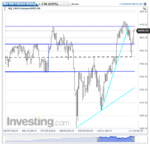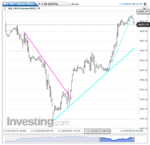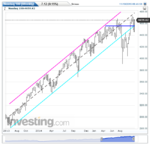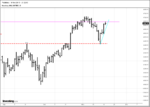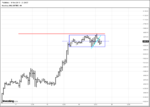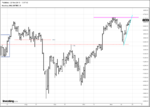Due to questions and issues that have arisen recently, I've added something on timeframes to the book. It's too much to post: 12 pages. But the beginning of it may provide something to chew on while preparing for tomorrow's trading:
Trading opportunities: whether or not one takes them, they exist. Or existed at the time. Whether or not one didn’t or wouldn’t take them – out of inattention, fear (Appendix F, the SLAB), ignorance – does not change the fact of their existence (see, at the least, “Trading Opportunities”, p. 49, Notes). If one has not mastered the “primer”, i.e., the SLA/AMT as set forth in pp. 36 thru 57, he will not likely benefit from the rest of the book. That mastery is achieved by reading, study, practice, reviewing the charts and one’s efforts, and maintaining meticulous records of one’s notes (see in particular “Developing A Plan” and Appendices D and E in the SLAB as well as here in Notes). One must, in short, in order to take advantage of these opportunities, know what to look for and what to do with it if and when he finds it.
The struggling trader quickly comes to the conclusion that the best entry invariably occurred an hour ago. Or yesterday. Or two days ago. Or last week. He somehow never sees them in real time, either because he’s focused on himself (“where do I enter?”) rather than on price movement (see “A Final Note”, the SLAB, p. 33, again), or because he’s become entangled in defining “retracements”, for example, in excruciating detail due to his fears (Appendix F again) rather than focus on danger points (p. 65, Notes) and where he can enter based on those danger points and the number of ticks he’s willing to risk independent of whatever the bars “say”, or because he hasn’t prepared properly or thoroughly and though he may think he knows what to look for doesn’t know where to look for it (weekly>daily>hourly>etc). The trader who has studied the rules on p. 9 and the “Crib Notes” on p. 19 (the SLAB) and applied them to all the examples everywhere and still finds himself stuck in The Land of CouldaWouldaShoulda may find a leg up by understanding just who it is that he’s trading with (with, not against). Trading the auction market profitably requires more than a knowledge of how to draw a trend channel or box. One must also achieve some understanding of the participants. One of the more extreme examples is the scalper vs he who focuses on weekly charts. If the trader wants to hold something for more than a few minutes, much less a few hours or days, he must understand that focusing on the 5s chart is a waste of time and effort in that those who are also focusing on that chart or T&S display have no interest in hours and days. The trader who hasn’t thought out his goals thoroughly is therefore out of synch with the market from the getgo. This is not a recipe for success.
There is also the matter of Who’s Got The Money to consider. Scalpers are undeniably busy, but they don’t move markets. They’re not the ones who are attempting to support price as it falls. They are not the ones with the power to engineer sustained breakouts. They are not the ones who are creating those trend channels. If one then wants to trade with the flow of bigtime money, which is arguably a more efficient and profitable method of trading than swinging at shadows, then he needs to understand what bigtime money is looking at. If he can also acquire an understanding of what bigtime money is most likely to do with it, he’ll be in a far more secure position that just about every trader out there, including some of those who have bigtime money but don’t know quite what to do with it.
One must remember that the more obvious the movement, however it is displayed, the more people there are who will see it. Therefore, if one trades EOD using daily bars, he's going to have an awful lot of company. Everybody sees that. Everybody. But if he's trading 5-second bars, not so much. Therefore, he's more likely to take quick profits because the trading crowd he hangs around with is generally not in this for the long haul. This is NOT to suggest that each and every trade should – much less must – be taken off a long-interval chart: daily, weekly, whatever. The point is to be aware of what all the various players are focusing on and use that awareness to one’s advantage. Whether one is trading off a 5m chart, or a 15m, or an hourly, it pays to know what everyone else is looking at and enter at those points and levels where the larger group or groups is/are mostly likely to join in and propel the trader into profit. Trading in a vacuum is not only inefficient but generally unprofitable.
That not every group of traders is looking at the same thing is most easily understood by noting the level of trading activity: the fewer participants, the less activity; the more participants, the more activity (for the purpose of getting through this, we won’t quibble about the differences between transaction volume – number of transactions – and share volume – number of shares changing hands; in terms of price movement, it really doesn’t matter). In other words, if everybody is looking at the same thing, such as a major parabolic move, then everybody is trading and there’s tons of activity. But if the money players aren’t paying attention, aren’t interested (as they wouldn’t be in itty-bitty movements on a tick chart or T&S display), then there’s much less activity. When the little players notice the big moves that are initiated and sustained by the big players, they join in (if they’re smart; the stupid ones will short the upmoves and buy the downmoves in the fond belief that they’re smarter than they really are, thus adding fuel to the moves they’re taking the opposite sides of).

